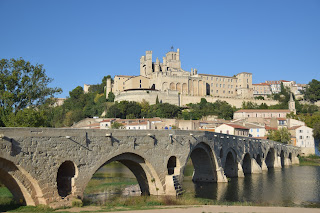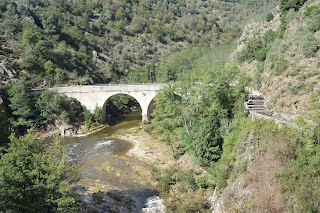After Le Boat and with Australia not making the QFs our team sadly disbanded. We had a site booked in Montpelier and headed for a few days exploring part of Occitanie.
Our
first stop was the very well known UNESCO listed Pont du Gard. Built over a
short period of 15 years way back in 50 AD this Roman aquaduct transported
water from Uzes some 50 kms away to Nimes. It is 50 metres high and 270m long
but the stand out figure is the fall along its length which is only 25mm. Such
precision without any sort of mortar is a real testament to the skill of the
stonemasons. At the downstream end the water went immediately into a 70 metre
tunnel.
The Romans spent a good deal of
time in this area and in Nimes there is a temple locally called Maison carrée (square
house) inaugurated in 4 AD.
And
a large amphitheatre which is dedicated to bull fighting.
Many places have these Roman
structures but what is unique to Nimes is the end of the aqueduct. The water
entered from a square hole using a sluice gate for control and was then
dispersed around the town via ten pipes. There were also three drain holes in
the bottom.
By stark comparison the Musee de Romanite adjoining the
amphitheatre seems to display a façade that is falling apart. Its squareness
and fluid lines are designed as a contrast to the “bull ring”.
Nimes has had a focus for many
years on pedestrian ways (and has won awards for their endeavours). You can
safely amble round many statues and churches.
But the almost 1 km avenue down to the railway station had
real pulling power (what is at the end?)
A station reflecting in its own lights. If you are in the
area Nimes is a must see.
Helen insisted that we visited
Avignon as she wanted to see the town where the nursery rhyme “sur la pont
d’avignon” originated. The song originally appeared in an operetta in Paris in
1853 and here is the bridge. It used to have 22 arches but with war and
flooding this is now down to 4.
There is quite a bit more to the
city including the ramparts which even today are almost complete.
Meanwhile the theatre looks remarkably similar to the one in Beziere.
However, the largest structure belongs
to the catholic church – namely the popes palace. Built in the 1300’s this
gothic building is an amalgamation of two palaces (two popes) and as is apparent
from the ramparts has also had a defensive role.
As our caravan site was within a tram ride of the city, Montpelier needed an inspection. The statue of Louis XIV is quite intimidating. Imagine being a fallen soldier….
Not to be outdone the city also
has its own formidable Aqueduc (Saint-Clément). Built over a 13 year period (1753)
it took water a few kilometres away from Saint-Clément spring to the
city.
It enters the city via the arc de
triomphe
Montpelier is a lively town in large part due to its many students. One of the streets was decorated with some 400 umbrellas as part of ‘pink October’ to continue awareness of woman’s breast cancer.
While down by the coast more pink prevailed with these flamingoes.
Our last night in the Occitanie was spent at a great restaurant down by the colourful coastal port


























































